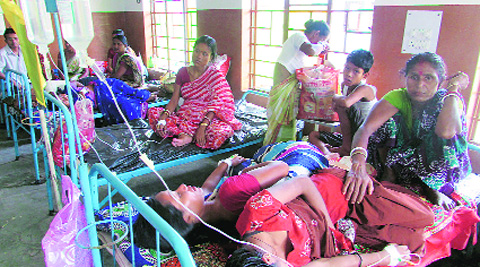- India
- International
Encephalitis: Pesticide found in litchi samples
Toll rises to 105; experts say too early to blame chemical
 Patients admitted with fever at Dhupguri Hospital in West Bengal’s Jalpaiguri on Tuesday. Source: Express Photo
Patients admitted with fever at Dhupguri Hospital in West Bengal’s Jalpaiguri on Tuesday. Source: Express Photo
Scientific investigations into the outbreak of acute encephalitis syndrome (AES) in West Bengal, which has claimed 105 lives since June, have revealed a pesticide has been found “above minimum safe limits” in the chemical analysis of litchi samples from Malda, but asserted that it was too early to “confirm its toxicity in humans”.
Tests of litchi orchards in Bihar’s Muzaffarpur, the other epicentre of the yet unidentified disease causing a similar AES, conducted over decades have never identified any toxin, experts said.
According to an expert from NVBDCP, “Pesticide Alpha Cyphermethrin was found above minimum safe limit in litchi samples. We tested the fruit samples because the villages are surrounded by litchi gardens, and since no pathogen was found in blood and other samples of patients, we started looking for toxins in surroundings.”
The Director of Muzaffarpur’s National Research Centre for Litchi said the pesticide was recommended for the litchi crop, but this finding showed that it had not been used as per “good agricultural practices”.
“It is suggested that the pesticide should be sprayed 45 days before harvest to ensure no toxin is present in the crop. So if the fruit samples have still showed its presence, it indicates that either it was sprinkled closer to the harvest or the quantity was more,” said Vishal Nath from the institute.

Noting that tests in Muzaffarpur had “never” showed the presence of the pesticide, Nath said, “Pesticides are after all poisonous substances, and can of course act as neurotoxins, but since it was just above minimum safe limit, it still falls within the safety range. We need to investigate more to see whether the pesticide was seen in the pulp, juice or the peel of the fruit, to analyse if it could actually be associated with the disease, but it seems unlikely.”
Neurotoxins are poisonous substances that can lead to convulsions or loss of brain function. Like Muzaffarpur, in West Bengal this year national investigators have not been able to identify the disease which is causing high fever, diarrhoea and convulsions in children. While the West Bengal Director for Heath Services said on Monday that a little over 20 of the cases are of Japanese Encephalitis (JE), investigative bodies from the Centre noted no such case has been identified in Malda.
Teams from the National Vector Borne Disease Control Programme, who visited the state over the last two months, and had samples tested by the National Centre for Disease Control and National Institute of Virology-Pune, said not a single case of JE has been identified in Malda yet.
An NVBDCP official said while these quantities of the pesticide can act as neurotoxins for rats and smaller animals, it is not so dangerous for humans. “We are consulting litchi experts from the Indian Agricultural Research Institute (IARI) for more details,” he explained.
Samples have been sent to Muzaffarpur’s National Research Centre for Litchi for detailed analysis. “The symptoms in West Bengal are very similar to Muzaffarnagar, barring the severe diarrhoea that we are seeing in Bengal. In Muzaffarpur too, tests on different samples of the victims conducted this year, have not been able to identify the cause or exact disease which shows symptoms that can be characterised under the broad definitions of AES or Acute Neurological Syndrome(ANS),” the officer explained.
Apr 27: Latest News
- 01
- 02
- 03
- 04
- 05








































